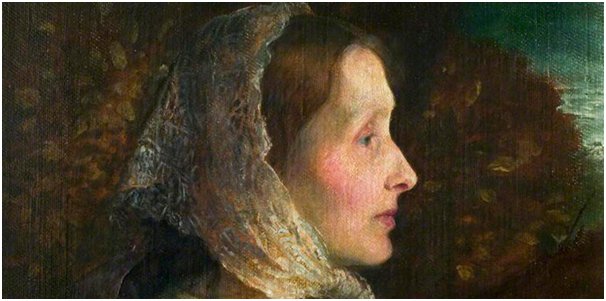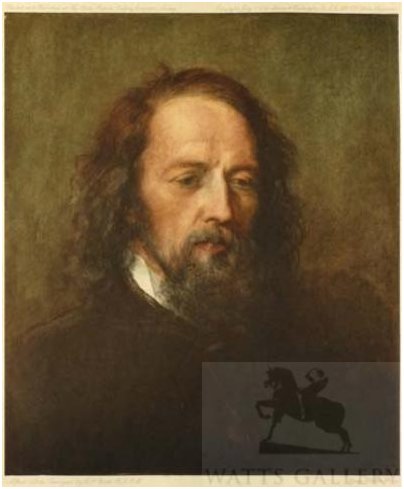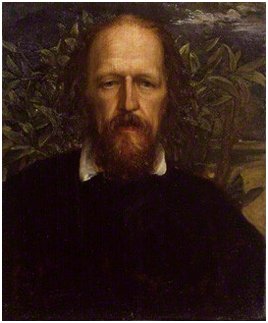In the Lancelot and Elaine section of The Idylls of the King Tennyson writes of Elaine’s reaction to having watched Lancelot in the hall during an evening meal:
And all night long his face before her lived,
As when a painter, poring on a face,
Divinely thro’ all hindrance finds the man
Behind it, and so paints him that his face,
The shape and colour of a mind and life,
Lives for his children, ever at its best (lines 329-334)
In this simile, Elaine’s focus on Lancelot’s face is compared to that of a portrait painter dwelling on the face of his subject and producing in his image of that face a representation of the sitter’s interior life. This is what G. F. Watts achieved in his paintings of Emily and Alfred Tennyson.
In my last blog on Watts I discussed his time on the Isle of Wight; he cherished the place not only for its natural beauty, but for the friends he had there. When he was recovering from the failure of his marriage, one can imagine that he welcomed the peaceful influence of Emily Tennyson.

The portrait above shows her to be a pensive, delicate woman. This is clearly a portrait of a woman Watts held in great esteem. Everything in it seems to be designed to draw our gaze to her eyes as she contemplates something in the distance. It is in his depiction of her eyes that Watts most clearly communicates his sense of her kindness. These eyes could never be cruel or heartless.
Watts’ detailed rendering of the lace head covering serves to highlight Emily’s physical delicacy and to hint at her constitutional delicacy. Despite the rough canvas on which he painted, possibly the only type available in Freshwater at the time, Watts makes her skin look clear, smooth, and almost fragile. Though she has a healthy bloom in her cheek, Emily looks like a woman capable of great love and compassion, but likely not of great feats of strength.
 Just as he makes clear his feelings for Emily in his portrait of her, Watts’ portraits of Tennyson reveals his deep respect for his poet-friend. Watts first painted Tennyson’s portrait in 1858. While sitting for this portrait, Tennyson composed much of the Guinevere section of Idylls. Emily was not impressed with this portrait because she felt it didn’t capture her husband’s poetic spirit; she asked him to paint another.
Just as he makes clear his feelings for Emily in his portrait of her, Watts’ portraits of Tennyson reveals his deep respect for his poet-friend. Watts first painted Tennyson’s portrait in 1858. While sitting for this portrait, Tennyson composed much of the Guinevere section of Idylls. Emily was not impressed with this portrait because she felt it didn’t capture her husband’s poetic spirit; she asked him to paint another.
This is a photogravure copy of the second portrait; it is archived at the Watts Gallery. The original painting is in a private collection. This portrait captures the ruminating nature of the poet. His downcast eyes suggest he is lost in inward contemplation, oblivious to his surroundings for the time. It is easy to imagine Tennyson, as depicted here, is composing poems he will later commit to paper.
Below is a latter portrait of Tennyson. Watts painted this one in 1863-64 and it is in the Watts Hall of Fame. Once he overcame his reluctance to paint portraits, Watts set out to capture the images of the age’s worthies. His Hall of Fame includes, among others, Cardinal Manning, Thomas Carlyle, William Ewart Gladstone, William Morris, and John Everett Millais.
 In the portrait of Tennyson, left, as in the others, the focus is on the man; his clothes and surroundings are of secondary importance. He looks dignified. His gaze in this portrait is higher than in the earlier one, but he is still not depicted as looking directly at the viewer. While the expression is less dreamy than the in the earlier one, he still appears to be lost in thought. Again, Watts has captured the poetic nature of his friend so that it lives not only for his children (Idylls, line 334), but for all time.
In the portrait of Tennyson, left, as in the others, the focus is on the man; his clothes and surroundings are of secondary importance. He looks dignified. His gaze in this portrait is higher than in the earlier one, but he is still not depicted as looking directly at the viewer. While the expression is less dreamy than the in the earlier one, he still appears to be lost in thought. Again, Watts has captured the poetic nature of his friend so that it lives not only for his children (Idylls, line 334), but for all time.